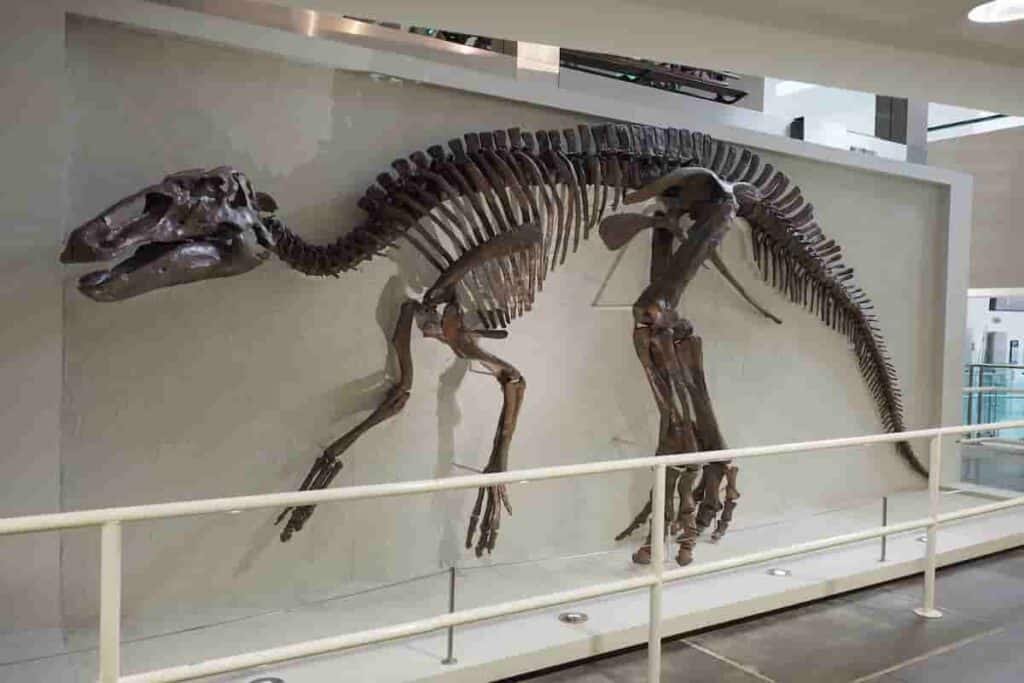When talking about fossils, we all know that these are remains of past living animals like bones and teeth, always the hardest part of the creature’s body. Now discovering a dinosaur fossil with its skin might be shocking to hear, but an absolute addition to the growing studies and findings made about the dinosaurs and their past lives. Let us travel down memory lane and meet some of the newest additions to the dinosaur fossil family.

What are the discovered dinosaur fossils with skin? The mummified skeleton of Canada, known as the Nodosaurus, is a perfectly preserved fossil with guts, armor, and some intact skin. Edmontosaurus is also the first dinosaur to include skin impressions. Scientists believe these fossilized skins to be a link to evolution.
This article will talk about the surprising discoveries of dinosaur fossils with skin.
Table of Contents
I will also talk about the significance of these skin fossils in the field of studies and how scientists view these skin fossils as linked to some of the similar modern animals with the same skin. Lastly, I will tackle the different circumstances that have caused the dinosaur skin to fossilized.
The Amazing Discovery of Fossilized Dinosaur Skin
Dinosaur fossils have been around and are continuously discovered by scientists and paleontologists over the years. But it is not common to discover fossilized skins of these creatures as skin is easily decomposed when the dinosaur dies. So knowing about these surprising discoveries will greatly help the scientists understand how the creatures lived in the past.
Unique Fossils of Dinosaur Skin
Bones and tracks are common discoveries of dinosaur remains. Finding a well-preserved soft tissue, like the skin, is an exceptional contribution in the scientific field as dinosaur skins are rarely fossilized. Only less than a percent of dinosaur discoveries contain traces of skin.
The fossils show the skin texture of the dinosaur but not the actual skin itself. The mummified skin leaves an impression on rocks that become fossils over time. It is rare because most dinosaur skins, like any other soft tissue, decompose quickly after death. According to studies, the discovered fossils show that dinosaur skins are rigid and scaly, which may be similar to modern reptiles with the same skin texture.
Nodosaurus: The Mummified Skeletons of Canada
One of the noted breakthroughs in dinosaur studies is discovering a fossil with guts, armor, and intact skin. The fossil is perfectly preserved like it is mummified, hence the name, mummified skeletons of Canada. These findings give us a hint of what dinosaurs look like and their similarity to other animals.
The discovery of the so-called dino-mummy is purely accidental. One day at work, the heavy equipment operator Shawn Funk hit something hard and unusual when manning an excavator at Alberta Millenium Mine. Mark Mitchell, a technician in the Royal Tyrrell Museum, worked carefully for a long time to remove the rocks surrounding the fossil. His work helped preserve the fossil for years and became known as one of the rarest mummified dinosaurs. This dinosaur was called the Nodosaurus, which lived in the late Cretaceous period around 110 million years ago. Experts also called it Borealopelta markmitchelli, which means northern shield of Mark Mitchell, in honor of his great contribution to the discovery. (Source)
Researchers suspect that the dinosaur was fossilized whole. However, only the front half of it was recovered, from the snout to the hips. They named it the best nodosaur fossil ever found as of the records.
Why was it so intact, unlike any other fossils? Scientists believe that the creature is buried under the sea after its death. Minerals under the sea have helped the skin and body parts be well preserved. The keratin layers that formed its armor are also well preserved, which is why the dinosaur was found intact like a mummy.
Paleontologists Take on Dinosaurs with Proto-Feathers and Scales
Professor Paul Barrett analyzed all the discovered dinosaur skin and mapped them out through an evolution tree to see their relationship. Results show that most dinosaur feathers are found in meat-eating dinosaurs, also known as theropods, having birds under the same group. It shows a close relationship between the origin of birds and dinosaurs that lived at the same time.
Scientists also studied the world’s only known T.rex skin and found no sign of feathers but smooth scaly skin. They also analyzed the skin impressions from a large Tyrannosaurus and found them covered in scales and not feathers. Experts presume that dinosaurs originally have scales on their skins, and having feathers are part of their evolution, not their biological trait. (Source)
How are the Rare Dinosaur Skin Fossils Formed
When dinosaurs die, their soft tissues, including the skin, will eventually decompose without leaving traces. Only the bones and teeth remain and become fossils after many years. So how are dinosaur skin fossilized?
The dinosaur skin fossils may be a product of skin impressions. Minisauripus left behind its skin mark in the form of soft footprints made of fine mud. Evidence suggests that the dinosaur stepped on a new raindrop mark, leaving a solid and perfectly traced impression. Then, the traces of skin were gently preserved by being covered with fine mud layers that solidify and become a fossil over time.
Another circumstance that allows dinosaur skin to fossilize is the presence of minerals from different bodies of water. Dr. David Button, a dinosaur researcher, explained that most fossils found were from species living near lakes or rivers. As the creature dies, its body may be washed away to the river by heavy rains. Upon burial, decomposition is slowed due to the lack of oxygen, giving the remains enough time to fossilize.
Some Amazing Dinosaurs Fossils with Skin
Here are some of the surprising discoveries of dinosaur skin fossils and the scientists’ and paleontologists’ findings of their origin and characteristics.
Edmontosaurus and Other Dinosaurs with Skin Fossils
Edmontosaurus mummy AMNH 5060 is the first dinosaur remains to include a skeleton covered with skin impressions from parts of its body. The exceptional and well-preserved dinosaur fossil was discovered in 1908 in the United States near Lusk, Wyoming, by fossil hunter Charles Hazelius Sternberg and his three sons at the Lance Formation. (Source)
Minisauripus is another species discovered to have footprints containing skin traces. It was found by a team led by Kyung-Soo Kim, Ph.D., from the Chinju National University of Education in South Korea. The scientists described the skin traces as “exquisitely preserved” and are one of the first to show skin impressions on a dinosaur’s entire footprint.
Researchers suggest that the skin traces are around 100 million years old, coming from a small carnivorous dinosaur named Minisauripus. The traces are very similar to some bird fossils with skin traces on their feet in the same period, said Martin Lockley, another author of the study from the University of Colorado. He also further explained the possible connection of these birds to the small carnivores.
The preserved skin is similar to medium-grade sandpaper with tiny scales measuring about a third or half of a millimeter in diameter. These scales are remarkably similar to the skin on the feet of a mummified feathered bird found in China.
A dinosaur embryo skin impression was also discovered for the very first time at a large nesting site in Argentina, South America. It was approximately 70 to 90 million years old. Some eggs contain embryos with patches of fossilized baby dinosaur skin, with scaly surfaces similar to modern lizards.
The Significance of Dinosaur Fossilized Skin Findings
The discovery of fossilized skin impressions is a great addition to the field of science. Impressions from dinosaur skin give paleontologists an idea of its texture and how it looks and compares them with modern-day species.
The fossilized skins help scientists uncover the possible link between dinosaurs and birds with the resemblance in their skin imprints. It also helps us understand the past living animals by studying their preserved fossils.
Uncovering rare dinosaur skins offer insight into evolution. Comparing the discovered fossilized skin to animals with the same skin texture may be a link to evolution. For instance, according to Mauricio Barbi, the hadrosaur from the late Cretaceous period was very similar to the skin of a modern crocodile. Another remarkable comparison is the thick hide of a Psittacosaurus, which is believed to be similar to the modern shark skin.
Conclusion
The discovery of these fossilized dinosaur skins has made a huge impact in the field of science. The use of this data enables scientists and paleontologists to look deeper into the past and find out how creatures lived. They may not be alive in the present times, but learning about them will hint at what these dinosaurs are capable of and their possible connection to our present lives.
